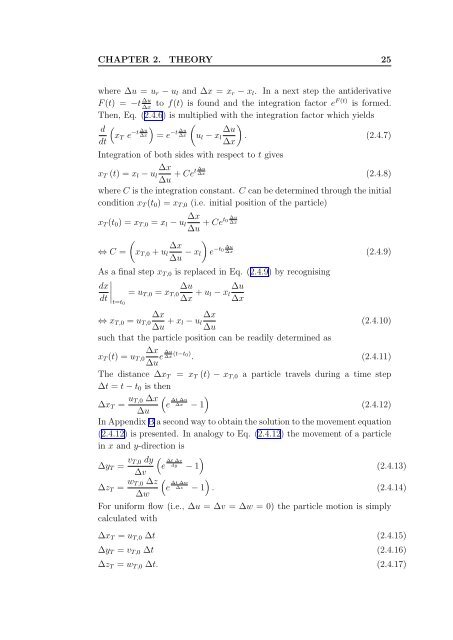Three-dimensional Lagrangian Tracer Modelling in Wadden Sea ...
Three-dimensional Lagrangian Tracer Modelling in Wadden Sea ...
Three-dimensional Lagrangian Tracer Modelling in Wadden Sea ...
You also want an ePaper? Increase the reach of your titles
YUMPU automatically turns print PDFs into web optimized ePapers that Google loves.
CHAPTER 2. THEORY 25<br />
where ∆u = ur − ul and ∆x = xr − xl. In a next step the antiderivative<br />
F (t) = −t ∆u<br />
∆x to f(t) is found and the <strong>in</strong>tegration factor eF (t) is formed.<br />
Then, Eq. (2.4.6) is multiplied with the <strong>in</strong>tegration factor which yields<br />
d<br />
� � � �<br />
∆u<br />
∆u<br />
−t −t ∆u<br />
xT e ∆x = e ∆x ul − xl . (2.4.7)<br />
dt<br />
∆x<br />
Integration of both sides with respect to t gives<br />
∆x<br />
xT (t) = xl − ul<br />
∆u<br />
where C is the <strong>in</strong>tegration constant. C can be determ<strong>in</strong>ed through the <strong>in</strong>itial<br />
condition xT (t0) = xT,0 (i.e. <strong>in</strong>itial position of the particle)<br />
∆x<br />
xT (t0) = xT,0 = xl − ul<br />
�<br />
⇔ C =<br />
xT,0 + ul<br />
+ Cet ∆u<br />
∆x (2.4.8)<br />
∆x<br />
∆u<br />
∆u<br />
− xl<br />
+ Cet0 ∆u<br />
∆x<br />
�<br />
∆u<br />
−t0 e ∆x (2.4.9)<br />
As a f<strong>in</strong>al step xT,0 is replaced <strong>in</strong> Eq. (2.4.9) by recognis<strong>in</strong>g<br />
�<br />
dx�<br />
�<br />
∆u<br />
= uT,0 = xT,0<br />
dt<br />
∆x + ul<br />
∆u<br />
− xl<br />
∆x<br />
� t=t0<br />
∆x<br />
⇔ xT,0 = uT,0<br />
∆u + xl<br />
∆x<br />
− ul<br />
∆u<br />
such that the particle position can be readily determ<strong>in</strong>ed as<br />
(2.4.10)<br />
∆x ∆u<br />
xT (t) = uT,0 e ∆x<br />
∆u (t−t0)<br />
. (2.4.11)<br />
The distance ∆xT = xT (t) − xT,0 a particle travels dur<strong>in</strong>g a time step<br />
∆t = t − t0 is then<br />
∆xT = uT,0 ∆x<br />
� �<br />
∆t ∆u<br />
e ∆x − 1<br />
∆u<br />
(2.4.12)<br />
In Appendix B a second way to obta<strong>in</strong> the solution to the movement equation<br />
(2.4.12) is presented. In analogy to Eq. (2.4.12) the movement of a particle<br />
<strong>in</strong> x and y-direction is<br />
∆yT = vT,0 dy<br />
� �<br />
∆t ∆v<br />
e dy − 1<br />
∆v<br />
∆zT =<br />
(2.4.13)<br />
wT,0 ∆z<br />
� �<br />
∆t ∆w<br />
e ∆z − 1 .<br />
∆w<br />
(2.4.14)<br />
For uniform flow (i.e., ∆u = ∆v = ∆w = 0) the particle motion is simply<br />
calculated with<br />
∆xT = uT,0 ∆t (2.4.15)<br />
∆yT = vT,0 ∆t (2.4.16)<br />
∆zT = wT,0 ∆t. (2.4.17)

















